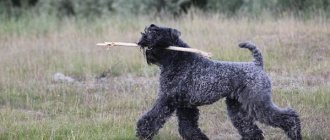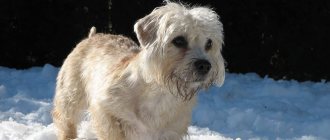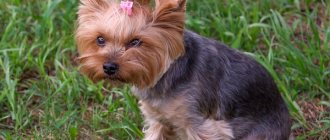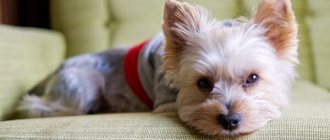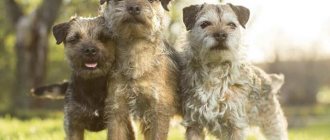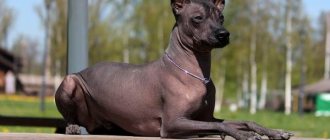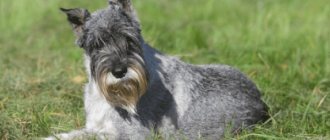The Kerry Blue Terrier (KBT) is a bright breed of dog, distinguished by its original appearance and wayward character. When a person decides to let a representative of this breed into his family, he has a lot of questions regarding caring for the dog’s coat, proper upbringing, and the peculiarities of keeping such dogs in the house. This article will help answer them.
Origin story
The Kerry Blue Terrier was bred a couple of hundred years ago, so there is no exact information about how this happened. It is known that she appeared in the small county of Kerry in Ireland and was initially an assistant to people: she helped herd sheep, guarded land, fought small pests in the house, and sometimes took part in hunting. For this, the dog was loved and appreciated by ordinary Irish farmers.
Rural life has always involved a large number of tasks, and some of them were successfully carried out by dogs. The ancestors of the Kerry Blue were the Black and Tan English Terrier and the Irish Wolfhound. From them, KBT received an excellent sense of smell, a unique coat color, and the skills of a good swimmer, hunter and watchman.
The spread of the dog breed beyond the country's borders occurred in the last century. Once in Europe, she ceased to be a hunter and watchman and was perceived by breeders as decorative, although she did not lose her skills. It was the Europeans who started the habit of caring for the dog’s beautiful blue fur, combing it, cutting it. The Kerry Blue Terrier standard was registered in 1922. Today the breed is no longer considered an ornamental breed. They work together with the person. For example, they serve in the police, where the dog’s sense of smell is especially valued.
How to choose the right puppy?
The Kerry Blue Terrier breed is not very common in Russia; puppies can only be found in specialized nurseries registered in the RKF/FCI. In order not to make a mistake in your choice, you should not believe verbal descriptions or photographs - you need to inspect the litter in person.
Healthy puppies are cheerful, playful and curious. They have shiny fur, lively eyes, clear skin and mucous membranes. It is recommended to meet the parents to make sure there are no hereditary pathologies.
The cost of a purebred puppy ranges from 15 to 25 thousand rubles.
The price of purebred Kerry Blue Terriers brought from Ireland is much higher - from 60 thousand rubles.
Description of the breed
The Kerry Blue is a small breed with a strong but graceful build and well-developed muscles.
The breed is recognizable due to its narrow, elongated head with an almost imperceptible transition from the frontal part to the muzzle and a thick beard. Black eyes are barely noticeable. The ears of the KBT are always directed forward, due to which they are located very close to the cheeks.
The neck is long and powerful, but looks very proportionate on the animal. The chest is wide and the legs are straight and strong. The tail is thin and straight at birth, but is most often docked in young puppies.
Color
The color of a dog's coat is a special pride of its owners. Representatives of the breed can have all shades of blue - from dark steel to light silver. Moreover, immediately after birth, puppies are more likely to be black in color. Only a couple of years later does the wavy coat acquire its famous blue hue.
Height
The height at the withers in males reaches 45-49 cm, in females – 44-48 cm.
Weight
Moreover, the weight of both is the same - 15-18 kg.
Characteristic
Coming from Ireland itself, Kerry Blue Terriers are often called the Irish Blue Terrier. Because of his delightful coat color, he received the name Blue Terrier. The dogs received part of the name of the breed (Kerry) as a tribute from their place of origin - the Irish county of Kerry. Sometimes these terriers are called Dutch rat catchers, as they mercilessly destroy any rodents and small animals in general. It is the hunting blood that “plays” in them.
Kerry appeared in exhibition events in 1913, almost immediately winning the title of almost ideal dog. In the FCI breed standard they received No. 3.
By standard, Kerry has a lot of external features. These unique dogs differ in literally everything, even their haircut. These terriers must be perfectly proportional, physically developed and at the same time maintain their compactness. Blue Terriers are distinguished by their rectangular body and muzzle shape.
The structure of the head also has a unique feature. It is always somewhat elongated, as if flattened, and the transition from the forehead to the nose is difficult to distinguish. The jaws remain strong, powerful and deep. The dog is characterized by its beard. Kerry's ears are always triangular. To fix them in this position, puppies have their ears “glued together” so that they do not stick out.
Kerry Blue Terrier – Kerry Blue Terrier character
The neck is a special pride of the Kerry Blue Terriers. It is raised proudly, very strong and elongated. In general, posture in this breed is incredibly important. The back line should be completely straight. Slouching or bending is completely unacceptable. The Blue Terrier's chest is quite wide and deep, and the ribs are characteristically arched. The front and hind legs should be straight with strong bones and powerful. The hind legs should have pronounced rounded knees. The feet must be rounded.
The tail is erect. Like a continuation of the ideal back line. Kerry must carry it vertically, or at least straight, on his own. Previously, it was necessarily stopped by 2/3. Nowadays, docking is considered illegal in many countries.
Wool is the incredible pride of all representatives of this breed. It feels perfect to the touch - incredibly soft, like silk, very thick and a little curly. Their amazing coat is practically not subject to shedding, since Kerry cats do not have an undercoat. In addition, there are practically no allergies to the hair of this breed, and the dogs are considered hypoallergenic.
Any deviations from the standard will not disqualify the dog. There is not a single disqualifying point in the breed standard.
Features of color
Blue Terriers have unique coat pigmentation. After 2-3 years, the color fades and then the animal gets its incredible color. Until this age, Kerrys are either completely black or partially pigmented. However, if the characteristic colors do not appear at least partially after one and a half years, this will already be considered a deviation in the breed.
After recoloring, any shades of blue and blue-gray are acceptable. The black tips of the hairs may remain. The eyes are exceptionally dark. Even light brown ones, not to mention very light ones, are unacceptable. The gums, palate and claws are distinctly black. Pink gums and palate, light nails are unacceptable.
Adult height and weight
The height of an adult cable can vary from 45.5 centimeters to 49.5. The height of an adult female varies from 44.5 centimeters to 48. Cables can usually weigh from 15 kilograms to 18, and females are slightly smaller.
Kerry blue terrier puppies
Puppy weight gain
Kerry Blue Terrier puppies are born weighing 200-340 grams. Development is quite fast:
- At 2.5 months - 3.5-4.5 kilograms;
- At 4 months – 7.5-8 kilograms;
- At 6 months – 11-13 kilograms;
- At 10 months they reach full weight.
Weight is focused on cable development. Girls may weigh less as they grow.
Lifespan
The lifespan of a pet depends on its care and proper maintenance. Kerry under normal conditions live up to 13 years, and in good conditions up to 15 years.
Cases have been recorded where representatives of the Kerry Blue Terriers lived to be 18 years old.
Allergenicity
The dog is positioned as hypoallergenic, as it does not have irritating undercoat and long hair. The hairs themselves also rarely cause allergic reactions.
Character and behavioral characteristics
Kerry Blue Terriers are one of the friendliest and most cheerful breeds in the world. They are energetic, playful, funny in many ways and therefore are favorites of adults and children. The Terrier can be called a breed suitable for large families, because they get along well with all family members, understand well the peculiarities of children's behavior, and, if necessary, can even help parents monitor their offspring.
Terrier temperament is more complex than it seems. This dog is inquisitive, proud, brave and stubborn at the same time. Intelligent but skittish, terriers do not get along well with other small animals, such as cats. In relation to other dogs, KBT can even show aggression, especially if we are talking about a male.
If you decide to get a Kerry Blue, be prepared to give all your love only to this dog, to be an attentive and caring owner. It is important that the characters of the person and the dog are equally strong, otherwise the pet will quickly become uncontrollable.
If you spend little time at home, this dog is not suitable for you. This breed needs constant interaction with people and does not tolerate loneliness very well. Terriers will follow their beloved owner anywhere, even on a trip.
Interesting Facts
- Kerry Blue Terriers are a multifunctional breed. At home, they protect herds of livestock and farmers' property, and hunt a wide variety of game, including waterfowl.
- Animals with a darker coat color often win at shows. This has led to an overall darkening of the breed's color, although Kerry Blue Terriers with light blue fur are never culled.
- Another name for the breed is Irish Blue Terrier.
Expert opinion
Leonid Rodin
Experienced dog breeder
Ask a Question
The Kerry Blue Terrier can historically be called a male dog. For some reason, it was the representatives of the stronger half of humanity who appreciated this noble dog. The most famous of the blue terriers was most likely Prisoner 224, owned by Michael Collins, a statesman and fighter for Irish independence. During the revolutionary confrontation between Britain and Ireland in 1920, the parties decided to postpone the fight in order to hold a terrier exhibition. At this tournament, "Prisoner 224" won the cup, and his owner's name is still engraved on the Kennel Club's honorary award. Collins even wanted to make the Kerry Blue Terrier the official national symbol of a free Ireland, but his early death prevented this plan from coming true. Later, famous boxers fell in love with Kerry Blue Terriers. Such a dog was owned by the English heavyweight Henry Cooper, who became famous for knocking down Muhammad Ali himself. Later, the no less eminent Jack Dempsey picked up the baton of the Kerry Blue Terriers. He was so aggressive in the ring that he even became Mike Tyson's idol. World champion Gene Tunney is another owner of a blue Irish terrier. Among the fans and owners of Kerry Blue were the American singer and TV presenter Perry Como, film directors Michael Mann and Alfred Hitchcock. Unfortunately, such an eminent circle of fans could not save the breed. It is listed as endangered by international canine organizations, and registrations of new puppies have long been below 300 entries per year.
Education and training
In order for the Kerry Blue to be healthy and happy, its owner must take care every day that the dog spends all its accumulated energy and takes a lot of walks. It is important to provide the dog with the opportunity not just for quiet walks, but for real jogging. As for education, it requires consistency and patience. With the right approach, the dog will quickly learn skills and commands.
Young active dogs should not be trained for hours. Grueling workouts will not lead to the desired effect. It is enough to devote 10-15 minutes to one lesson. Learning should be dynamic, constantly changing. The same exercise will quickly tire the animal, and when the terrier is bored, he begins to look for entertainment on his own.
Raising a Kerry Blue requires real pedagogical skills from a person. Intonation, praise, severity and other tricks of a typical parent are important. And indeed, the CBT, like a child, must understand who is truly in charge in a human-dog pair. In this case, you will have to spend less time and effort on training. In most cases, it is enough to teach the animal basic commands, although they are capable of more and remember the material almost immediately.
Dog Character Traits
This breed of dog was bred for herding work. The main characteristics of the breed are:
- Playfulness.
- Affectionate – it’s comfortable to play with dogs, just like adults and children.
- Dogs during games, as well as without them, are characterized by a certain amount of noise.
- In general, the dog is balanced, without obvious manifestations of aggression.
- The dog is clearly friendly both to its owners and to the people around it.
- The dog is sociable, so it should not be owned by people who value privacy. She loves to play and be the center of attention.
- Well suited for families with children.
- The dog is distinguished by its devotion to the family in which it grows up.
- But in raising a Kerry Blue Terrier it is not permissible to allow rudeness or spanking, since she remembers well the rudeness in treating herself.
A dog needs a firm hand from an owner who will love it and devote a lot of time to it.
Diseases and care
A healthy and well-groomed Kerry Blue lives with its owners for 12-15 years, but a tendency to a large number of diseases can greatly ruin the dog’s life. Among the most popular diseases in CBT are:
- hip dysplasia;
- entropion of the eyelid;
- dislocation of the kneecap;
- hypothyroidism;
- otitis;
- cataract;
- and even cancer.
The following diseases can be avoided if you provide the animal with proper care:
- Provide your terrier with good exercise every day. Swimming and running are especially valued by the animals themselves; other types are also suitable.
- Groom your coat daily. It is necessary to comb the thick coat every day, and in addition, groom and bathe your pet at least once a month.
- Clean your ears, teeth, and claws regularly. The latter also need to be trimmed periodically.
- The paw pads and eye health of the terrier require especially close attention, as they are the weak point of these dogs. At the first appearance of symptoms of the disease, contact a specialist.
Feeding
The Kerry Blue diet should be balanced and stable. In the first 2 months of life, a clear regimen is established: first the dog is fed strictly 4 times a day, and then the number of feedings is gradually reduced to 3 and 2 times a day. A small puppy additionally needs to be fed milk after each main meal.
As for the diet, the following are unacceptable:
- soups;
- sweets;
- fat meat;
- pasta;
- potato;
- bakery products;
The listed products contribute to the very rapid development of stomach diseases in the terrier.
The optimal feeding for the breed is a special balanced premium food. In this case, eating should be accompanied by several rules:
- food is given at a strictly designated time;
- If the dog does not eat the entire portion, the leftovers are removed.
- Unscheduled snacking of the animal should not be allowed;
- all food should be at room temperature, so you should not keep food in the refrigerator;
- Feed nutrition does not require additional vitamins and minerals for animals, however, it would be useful to additionally consult a doctor about this possibility.
Price and where to buy a puppy
The average price of a carry blue with a good, albeit not champion, pedigree reaches 30,000 rubles. To avoid problems with documents, it is best to purchase them from nurseries that have been breeding KBT for many years. You can get acquainted with a successful breeder at an exhibition organized by the National Club, in this case be prepared for an inflated price. The offspring of champion dogs can be sold for 50,000 rubles or even more. On the other hand, you can be proud of the presence of champions in the animal's pedigree, and over time, perhaps, you yourself will become an experienced breeder. In any case, think carefully about purchasing Kerry Blue.
When you decide to become the owner of a Kerry Blue, remember that you are providing yourself with a reliable friend for many years who will follow you anywhere in the world. They adapt well to external conditions if they receive enough love, affection and care. Representatives of the breed should be treated like family members, who will help in difficult times, protect, and cheer. If spending a lot of time with an animal is problematic, forget about this breed so as not to torment the dog with loneliness and inattention.
Caring for the Kerry Blue Terrier
When properly trained and socialized, Kerry Blues are loyal, obedient and athletic. These dogs are very alert and can make good watchdogs. They are also reliable playmates for older children, but may not be as well suited to homes with small children.
Wondering how friendly Kerry Blues are with other pets?
Keep in mind that these feisty terriers were bred to hunt small vermin such as mice and rabbits, so their hunting instinct tends to be strong.
They are not generally recommended for homes with cats or other small animals, but early socialization and training can offset this natural need to hunt.
When it comes to other dogs, you should know that some Kerry Blues can be aggressive.
This does not mean that the Kerry Blue will never happily coexist in a multi-dog family or enjoy a friendly romp in the park.
But owners really need to be aware of this breed's personality and provide the right training and guidance to help this dog behave correctly and safely.
The word "terrier" within the Kerry Blue means that these dogs have a natural tendency to do things their own way. It is important that you establish clear leadership from puppyhood and remain enthusiastic about your training.
This dog's active mind requires constant and exciting challenges. Trainers recommend keeping classes fun and positive to engage the mind and heart of this intelligent breed.
Exercise is the key to the health and happiness of these dogs.
They make excellent jogging companions and can cover distances despite their relatively compact size. At the very least, you should expect to take your dog on several long walks a day.
They also benefit from having a yard, but they can dig, so you'll have to watch closely to make sure they don't escape.
If you are looking for an athletic dog that wins competitions, this dog breed is a great choice.
Caring for the terrier's soft, wavy coat cannot be discounted. Fine hair gets tangled easily and tends to collect debris. Brush your Kerry Blue's teeth at least every other day, although many breed experts recommend brushing it daily. On the other hand, the Kerry coat does not shed and is better tolerated by many people with dog allergies.
You will need to have this breed professionally groomed regularly. The coat is constantly growing, so a trip to the groomer will help keep this terrier's neat appearance. Usually every six weeks is enough to keep your terrier's coat under control.
The thick strands of hair that cover the Kerry Blue's face and eyes can be trimmed to give the dog a well-groomed appearance.
Briefly about the main thing
- The breed was developed almost two hundred years ago and was originally used as a human assistant in hunting and housekeeping.
- Kerry is a medium-sized dog, with a maximum height of only 48-49 cm in both sexes of the breed.
- The breed standard allows any shade of blue: the coat can be from dark steel to light silver.
- This is a great companion for you and your children, but only if it is the only pet in the family. Not a single representative of the breed will agree to share the owner with other animals.
- Representatives of the breed are prone to a large number of different diseases, and therefore require constant care. The ears, eyes and stomach are especially susceptible to disease.
- Feeding dogs of this species requires compliance with certain rules, violation of which leads to the development of serious diseases.
- It is better to buy a puppy from a nursery from 5,000 rubles.
Health
The average life expectancy of a Kerry Blue Terrier is 13-15 years. With proper care, a pet can live up to 16-17 years, as the breed is endowed with strong immunity.
The owner's responsibilities include: visiting a veterinary clinic once a year for preventive examinations, deworming, vaccination, and treatment against skin parasites.
An important health advantage of CBT is the fact that Kerry Blue puppies do not suffer from rickets.
In order to prevent and detect the disease in time, the owner must know what health problems the Kerry Blue Terrier is predisposed to:
- Abiotrophy is a neurodegenerative disease associated with impaired functioning of the cerebellum, and, as a consequence, motor skills.
- Entropy is an entropion of the eyelids that requires surgical intervention.
- Joint dysplasia - the disease causes unbearable pain to the dog; at the initial stage the terrier limps, at the last stage it may partially or completely lose the ability to move.
- Dermatitis is an inflammation of the skin that affects its entire structure without forming a rash.
- Cataracts are an eye disease; if left untreated, the dog’s vision first deteriorates, and then complete blindness may occur.
- Hypothyroidism is an endocrine disorder that can be congenital or acquired.
- Keratosis of the nose and foot - pathology occurs when the body begins to produce too much keratin.
- Oncological diseases.
- Knee dislocation - there is a lateral and medial dislocation.
- Ear diseases - often occur due to the fact that Kerry Blue's ears are close to the head, the auricle is not ventilated, as a result, microbes can develop in the wax, which lead to various types of infections.
